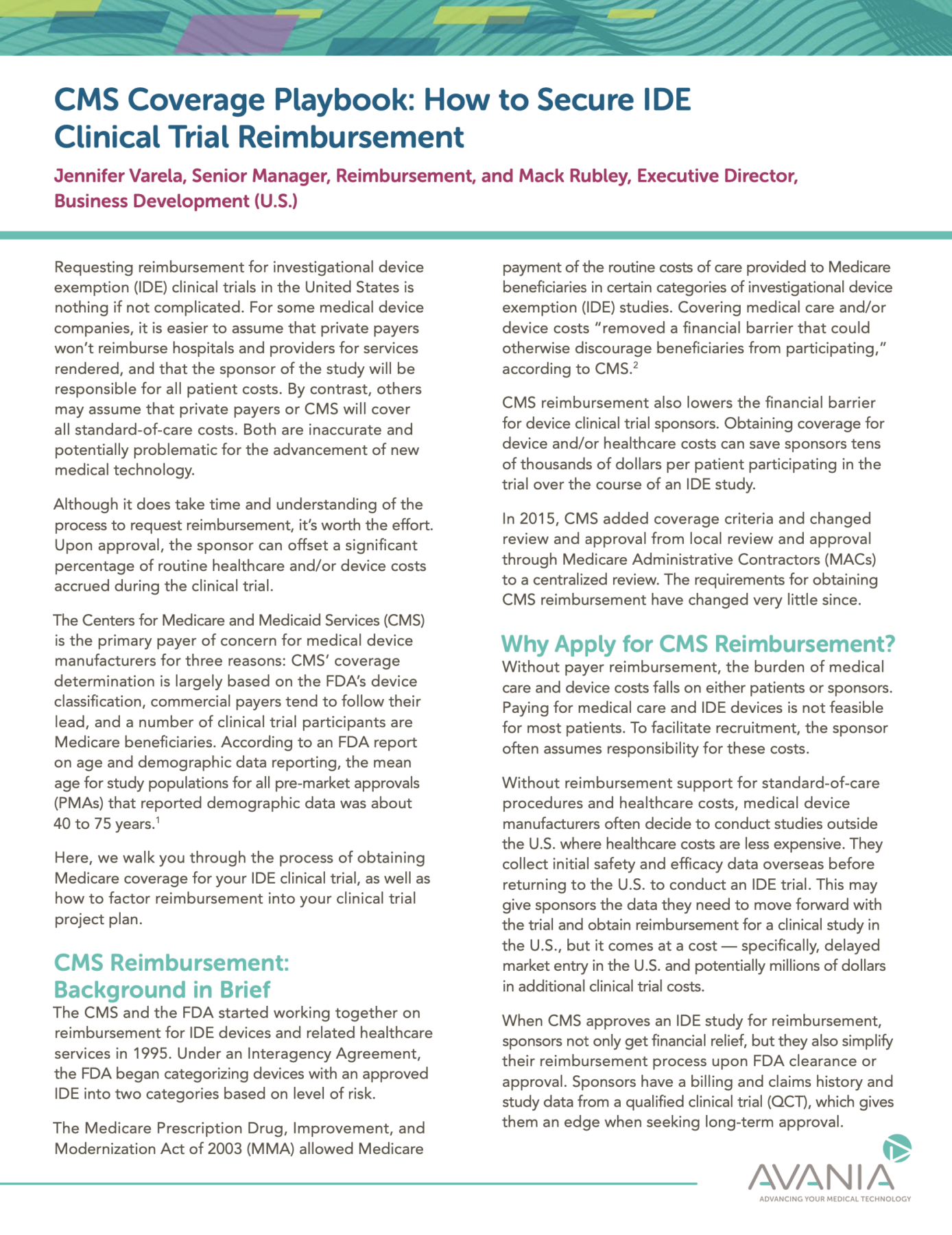Requesting payer reimbursement for investigational device exemption (IDE) clinical trials in the United States is complicated, to say the least. What’s more, some medical device companies assume payers won’t reimburse hospitals and providers for services rendered, so they put reimbursement on the back burner.
That’s a mistake. If payers approve your study for reimbursement, they’ll cover a significant portion of healthcare and/or device costs accrued during the clinical trial. Without reimbursement, you’re responsible for 100% of those costs. Because these costs make up such a significant portion of your budget, it’s best to know your responsibility as early as possible.
To increase your odds of approval, follow these five steps when submitting to the Centers for Medicare and Medicaid Services (CMS) for Medicare coverage for your IDE clinical trial.
For an in-depth look at how to obtain IDE study reimbursement, download our white paper:
CMS Coverage Playbook: How to Secure IDE Clinical Trial Reimbursement.
1. Factor Reimbursement Into Protocol Development
To keep your study budget and timeline on track, consider reimbursement when writing the protocol. Include all the information CMS needs to review (see #3).
In addition, budget time into your study to allow for CMS submission preparation, review, and potential re-review. Planning for reimbursement on the front end will help prevent enrollment delays later.
2. Review Your Category Designation
When the FDA approves or conditionally approves your IDE, it assigns the device to Category A or B. That category determines the extent of CMS reimbursement.
Category A — Experimental: CMS only covers routine costs of care. Routine costs include items and services otherwise available to Medicare beneficiaries. CMS does not cover the investigational item or service.
Planning a first-in-human study? Because of the paucity of data to support safety and effectiveness, and because of the risk of harm to participants, CMS may deny coverage.
Category B — Non-Experimental/Investigational: Category B coverage includes routine costs of care and the investigational device. While Category B designation increases the odds of reimbursement, it’s no guarantee. CMS may deny services that it deems not medically necessary.
3. Submit a Complete Request Packet
Once you obtain IDE approval or approval with conditions from the FDA, you can submit a packet to CMS to request Medicare coverage for your study. We strongly recommend using the checklist and crosswalk table created by CMS to walk you through the process. Include the completed crosswalk table to expedite review.
Other submission components include:
- Request letter that describes the scope and nature of the study
- Complete FDA approval letter for your Category A or B IDE
- IDE study protocol that includes descriptions CMS wants to see:
- Method and timing of release of results on all prespecified outcomes, including release of negative outcomes and that the release should be hastened if the study is terminated early
- How Medicare beneficiaries may be affected by the device under investigation
- How study results are or are not expected to be generalizable to the Medicare beneficiary population
- Institutional Review Board (IRB) approval letter
- The National Clinical Trial (NCT) number
- Any supporting materials
4. Change Categories, If Possible
Under certain conditions, you can request a categorization change with the FDA. For example, if you receive data from a feasibility study that resolves initial safety and effectiveness questions, you may be able to switch from Category A to B. Or, if an IDE study receives an approval with conditions, you may be able to change to Category B when those conditions are resolved.
5. Contact Your Sites
Once CMS approves your IDE study for reimbursement, the provider (e.g., the hospital or the investigator) contacts its regional Medicare administrative contractor (MAC) to start the notification process for clinical trial participation. The MAC will give the provider billing and coding information and any other requirements unique to that MAC.
When the study gets underway, the provider submits Medicare claims on behalf of patients. If there is no Medicare coverage in place it will be up to the sponsor to cover these expenses.
Remember, you don’t have to navigate IDE study reimbursement alone. Avania has legal, regulatory, and coding experts that can help demystify the process. We support sponsors and sites from application to approval and through the course of your clinical trial. Get in touch to find out how we can help you advance your reimbursement strategy.
For more information on how to obtain IDE study reimbursement, download our white paper:
CMS Coverage Playbook: How to Secure IDE Clinical Trial Reimbursement.

